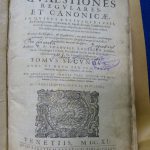The host volume A-V-180 of the library of the Franciscan convent in Zagreb was bound in a bifolium of the same antiphoner as the print under the shelfmark A-V-179: it is without a doubt that the two fragments are related. Furthermore, the host volumes are consecutive (first and second) volumes of the same book (Manuel Rodrigues, Quaestiones regulares, et canonicae in quibus utriusque iuris…, 1611). Possibly, they were bound in parchment at the same place – likely at the Zagreb Franciscan convent, where they stayed until today. This theory is supported by the multiple corresponsive possessor inscriptions (stamp and handwriting) and by the consecutive numbering. It is possible that the books were bound or rebound during a library revision into the parchment bifolia of the codex with outdated liturgical content. The medieval manuscript was cut up systematically, and the leaves may have been used as bookbinding in a consecutive order. The finding is exciting because the emergence of a new part of the parent codex may give us a chance to verify or contradict our opinion on the local Zagreb liturgical manuscript (see the description of F 1105).
The bifolium complements with new details the offices of Mary Magdalene and Inventio Stephani preserved on F 1105. Parts of the Office for Mary Magdalene are really informative: the chant order and selection of the Matins’ second and third nocturn were in range with 14th–15th-century Zagreb liturgical books and also with a few breviaries from the Szepes/Spiš region. The responsory Septem ergo Maria and its verse Quia semetipsam graviter are legible on F 1106 as the first responsory of the third nocturn, which seems to be a unique choice in the light of the comparative sources. The assignment of the responsory in this quite variable office is only stable in Kalocsa-Zagreb: we could not find it in the staple Esztergom tradition (nor in breviaries of Szepes, see Andrea Kovács ed., Corpus Antiphonalium Officii Ecclesiarum Centralis Europae V/B Esztergom (Strigonium), Budapest, HAS Institute for Musicology, 2006, 117, 233). The responsory did not come into general use, it is documented mainly in South-German traditions (comp. http://cantusindex.org/id/007638). The specific chant selection manifesting even within the Hungarian tradition seems to resolve the question about the origin of the parent codex.
A part of the office of Inventio Stephani deepens the thought of the Zagreb provenance. Compared to F 1105, an earlier part of the office is visible on the leaf, parts of the first Vespers: the responsory and the Magnificat antiphon. While the antiphon Ostendit sanctus Gamaliel on the bottom of the leaf has a relatively uniform liturgical position throughout Europe, this could not be said about the here visible responsory Cum scirem ego Gamaliel. The chant options of the Esztergom tradition are unstable at this point (the Cum scirem only occurs in a Szepes breviary: Budapest, Hungarian National Museum, 63.84.C). That is why the responsory’s consistent placement in the first vespers is so surprising in sources from Kalocsa-Zagreb (Andrea Kovács ed., Corpus Antiphonalium Officii Ecclesiarum Centralis Europae VI/B Kalocsa-Zagreb, Budapest, HAS Institute for Musicology, 2008, 91).
We can examine the characteristics of the parent codex’s notation as presented on F 1105. Consequently, it is more and more suspicious that a local workshop’s own tradition is in the background of the notation. The most important and emphasized neume forms, the left-leaning stem element, the great angle of the clivis and the changes in its size according to the interval – the most upfront characteristics of the musical notation – occur in further yet unidentified sources, first of all on the complete gradual leaf kept in the library of the Croatian Academy of Science and Art (Hrvatska Akademija Znanosti i Umjetnosti) under the shelfmark Fragm. 74 as the cover of a register dating from 1576. The antiphoner fragment of the Zagreb City Library’s Collection of Rare Books (Gradska knjižnica, Zbirka rara) can be grouped here regarding its notation (F 1113), whose notation shows the demanded neume variants. A 15th–16th-century Zagreb group of sources seems to outline these findings. The group is niche evidence of the sparingly documented medieval Zagreb tradition, and could give a stable point for identifying findings belonging to this group in the future.
Gabriella Gilányi




